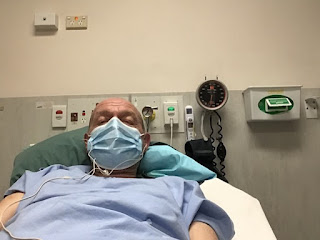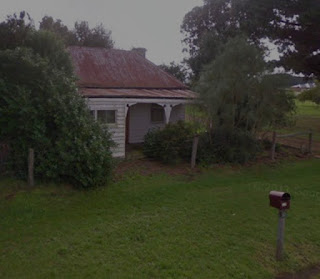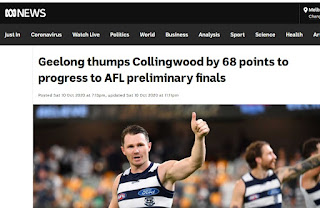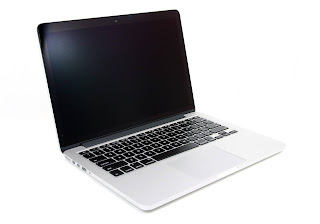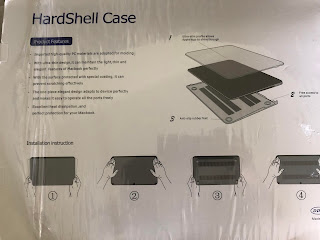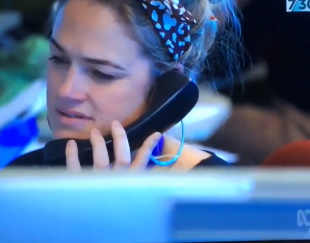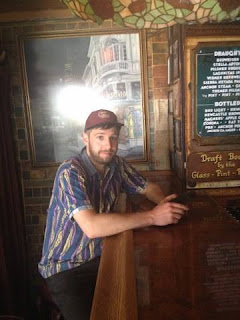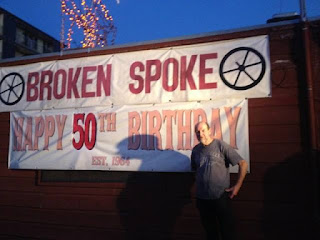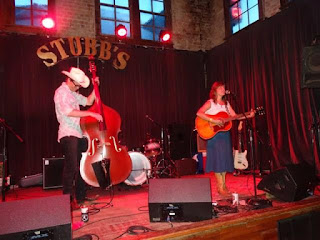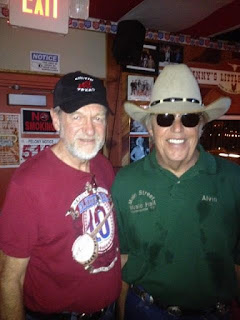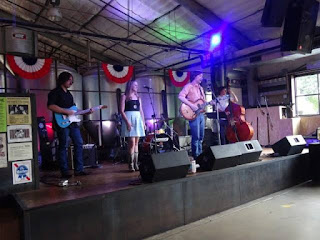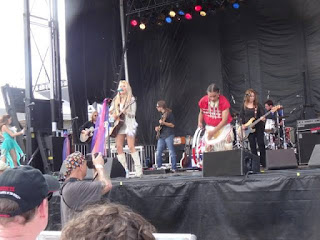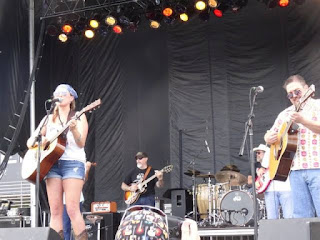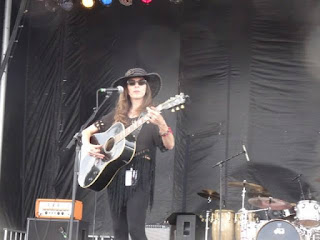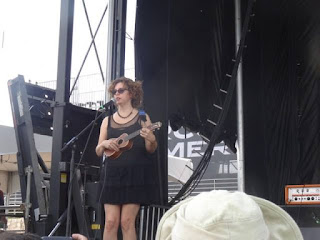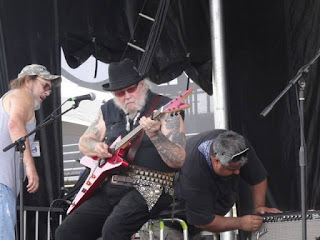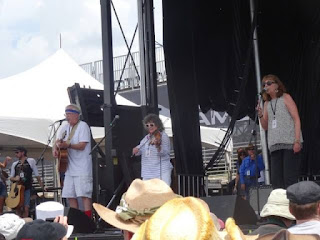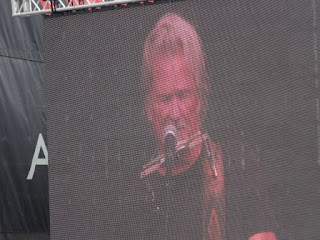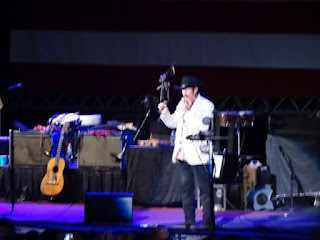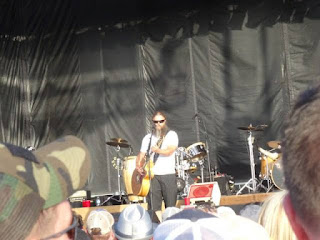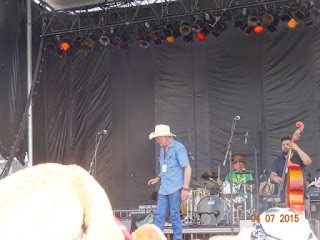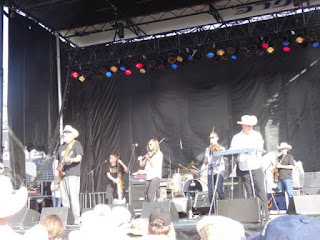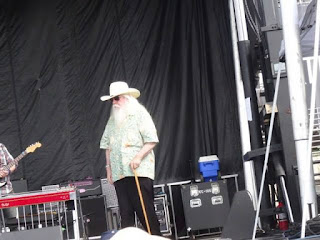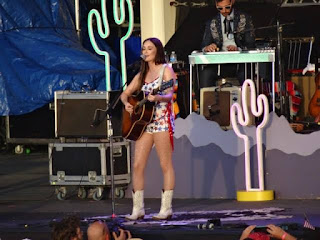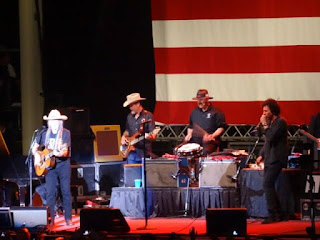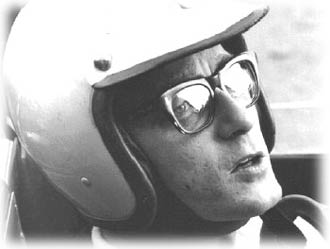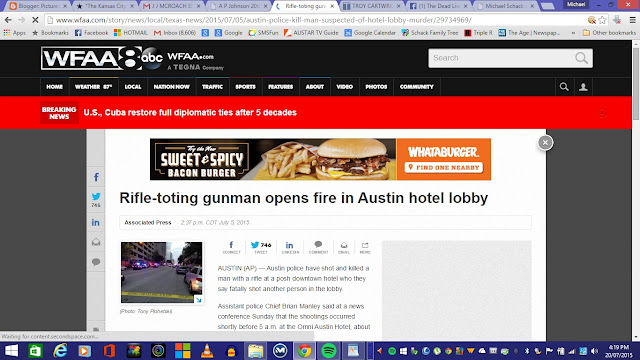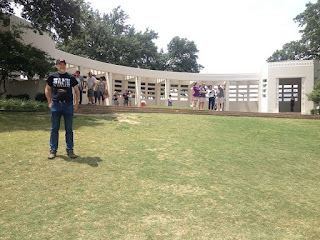Despite easing my back pain during the gruelling flight across the Pacific with temazepam and codeine I was able to greet the sniffer dogs at San Francisco International Airport with a fair degree of confidence. We took advantage of the $15 per head shower opportunity at the airport’s “Freshen up” franchise and it was only after leaving this facility that I realised my removable “ plate” with several artificial teeth attached to it was no longer in my mouth. I hurried back to ask the attendant if he had retrieved any teeth in the last half hour but received a negative response. A frantic rummage through my luggage located the missing teeth sitting comfortably in my toiletries bag.
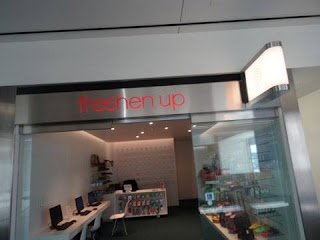
The next step was to negotiate the BART rail system to reach a station near our hotel in Union Square, and I was fortunate enough to secure a senior’s discounted pass. Checking in our bags at the hotel we ventured forth to the nearby cable car stop where there was a long queue of tourists being exhorted by a street preacher to follow Jesus. Deciding it may be quicker to walk we headed off in the direction of the Pier area where we were eventually to join our hippie kombi van “Love tour” of San Francisco. As we meandered the tourist laden pier precinct we had no idea that tomorrow 32 year old Kate Steinle would be gunned down at this very site by a 5 times deported illegal Mexican immigrant named Francisco Sanchez.

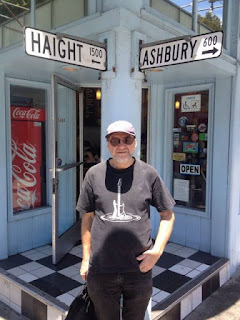
The kombi van tour bus allowed us to stop for a while in the Haight-Ashbury neighbourhood to see where Jerry Garcia once lived and to pick up a card offering a 20% discount on the first visit to the Love Shack Medicinal Cannabis centre. At the conclusion of the tour we stopped off at Johnny Rocket’s hamburger joint – part of a chain founded in Melrose Ave Los Angeles in 1986 by Ronn Teitelbaum.
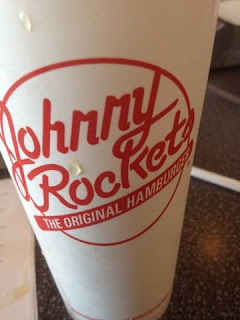
The food was questionable and we vacated to weave our way through a bottle throwing incident involving a local gang before arriving at the City Lights Book Store. Founded in 1953 by poet Lawrence Ferlinghetti and Peter D. Martin, the store was made famous by the beat generation. Who could then refuse the opportunity to have a drink at the nearby Vesuvio Cafe – an historic bar in located at 255 Columbus Avenue, across from Jack Kerouac Alley from City Lights Bookstore? The bar was founded in 1948 by Henri Lenoir, and was frequented by a number of Beat Generation celebrities including Jack Kerouac, Allen Ginsberg, Lawrence Ferlinghetti, and Neal Cassady, as well as other notable cultural figures such as Dylan Thomas, Bob Dylan, Rodger Jacobs and Francis Ford.
Eventually laid to rest at the hotel, I awoke the next morning with exacerbated back pain and applied some “ice gel” to my lower back – an act that would prove problematic an hour or so later at the airport security checkpoint when we flew out to Austin. An airport x-ray machine revealed a potentially explosive substance strapped to my rear torso and I was called aside for “patting down” before the guards reluctantly released me.
Will at the bar of the Vesuvio Cafe
The flight to Austin didn’t help the back much but we managed to arrive in time for the last of the free drinks at our hotel -- the Hampton Inn and Suites on San Jacinto Blvd. It was a simple matter of self-medicating enough to make it to the legendary Broken Spoke honky tonk as the Texan dusk descended on South Austin.
At the Spoke
We stumbled in as the 2-step dance class was in its dying stages and ordered some Mexican food before the band “Heybale” took to the stage. Singer Dallas Wayne announced that regular guitarist Redd Volkaert was busy having a penile implant but that they would soldier on. His fill in, Bryce Clark, did an admirable job, as did pianist Earle Poole Ball (best known for 20 years touring with Johnny Cash) and bassist Kevin Smith (Bee Spears replacement in Willie Nelson's family band). Our uber driver on the way home insisted that we had messed up by not attending the dance class where we would have been able to demonstrate to the girls that we were available. Too tired to debate this theory we agreed on “next time”.
Heybale
Waking to more back pain the next morning I considered contacting the Andrew Johnson Hotel in Knoxville to see if they knew the whereabouts of the doctor who had administered a mixture of morphine and vitamins to a pain ridden Hank Williams on New Year’s Eve 1952, but found it easier to locate a chiropractor on Congress Ave. The practitioner gave me a pelvic readjustment, charged a $65 fee, and issued a hand written receipt on a scrap of paper before disclosing he went to high school with Willie Nelson’s daughter Paula (whom he described as a “wild child”).
Christy Hayes
Moonlight social
Thus treated, I felt well enough to attend the early session at Stubbs BBQ to see a female artist named Christy Hayes and a band called Moonlight Social (which did a good version of the Civil Wars' “From this Valley”) before catching an uber ride to Ginny’s Little Longhorn Saloon for Alvin Crow. I reminded both Alvin and his guitarist John Reid that I had met them in 2001 but, not surprisingly, they showed little recognition of the fact. Our uber driver homewards entertained us with a constant dissertation of the Australian pronunciation of beetroot.
With Alvin Crow
The following day was a neo public holiday prior to Sat. July 4th and we availed ourselves of a guided tour of the Capitol Building (noting that at 308 ft tall the Texas State Capitol is 19 feet taller than the United States Capitol which is only 289 ft tall) and greater Austin (including the LBJ library).
In the evening we embarked on a jaunt to the Austin Beer Garden and Brewery to catch “The Merles” and “Choctaw Wildfire”. It was here that we encountered “Daniel” – a man in an advanced state of drunkenness celebrating his wedding anniversary and wanting to know why we weren’t dancing. When I said I don’t dance he suggested getting drunk. When I said I didn’t drink he asked if I could walk. When I said no, I had a bad back, he said that was perfect – a man with a bad back trying to walk would look like dancing. We also met Mike from Atlanta Georgia, in town for the Willie Nelson 4th of July Picnic, and in a celebratory mood. He publicly stated his dislike of Afro-Americans and claimed they didn’t work, shot people, and robbed innocents. He dismissed any suggestion of racism by indicating he didn’t mind Mexicans because “they work” – slightly at odds with news reports of a Donald Trump statement blaming Mexicans for importing crime. He was there with a friend Kevin, who had been pals with the late Poodie Locke (Willie Nelson’s long-time stage manager, friend and golf partner) and who told tales of accompanying a Willie Nelson tour to Amsterdam.
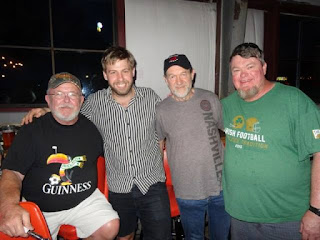
With Kevin and Mike
The Merles
Saturday July 4th duly arrived and we rose to secure an uber driver to take us the 20 miles to the Austin 360 amphitheatre where the annual Willie Nelson 4th of July Picnic was being held. Arriving about 11.15 am the impending 93 degree heat was momentarily held at bay by cloud cover. The opening act, Pauline Reese, was already in progress. Reese is an Austin based singer named female Vocalist of the Year & Entertainer of the Year at the 2012 Texas Music Awards, and had a swag of native American dancers to enhance her show and set the tone for the day.
Pauline Reese
Other early acts included Amber Digby – a great traditional country singer in her mid-thirties whose father played bass with Loretta Lynn, “Folk Uke” – the duo featuring Cathy Guthrie (daughter of Arlo) and Amy Nelson (daughter of Willie) who gave us some of our favourites including “Knock me up”, the Raelyn Nelson Band - a Nashville-based band mixing "old country and dirty garage rock” led by Willie Nelson’s granddaughter, and the Paula Nelson Band featuring Willie’s daughter. ( n.b. : Willie Nelson's 1963 marriage to Shirley Collie broke down in 1971, after Collie found a bill from the maternity ward of a Houston hospital charged to Nelson and Connie Koepke for the birth of Paula Carlene Nelson. Koepke and Nelson married the same year and had two daughters, Paula Carlene and Amy Lee).
Amber Digby
Folk Uke
Dallas Wayne, an Austin-based singer, songwriter, voice-over artist and on-air radio personality who was once part of the honky-tonk supergroup, the TwangBangers, and now fronts Heybale, preceded the first of the legendary names on the bill – David Allan Coe. The "front of stage" mosh pit swelled for Coe, who needed a walking stick and a helper to make it to a stool on centre stage. The impressive but aging (75) outlaw was about to launch into song after uttering the first amplified f word for the day when he realised his guitar was out of tune. A much younger technician got it in order and the crowd sang along to classics such as “Long haired redneck”, “If that ain’t country”, “Take this job and shove it” and “The ride”.
David Allan Coe
Ray Wylie Hubbard continued the crowd participation with “Up against the wall redneck mothers” and ushered in Greezy Wheels – the band that played support for Willie’s first ever performance at the Armadillo World Headquarters in Austin and were regarded as the house band at the Armadillo. The MC mentioned that an original poster for that gig would be worth $10,000.00.
Greezy Wheels
Some audience members were bemused to hear 80 year old Johnny Bush singing Whiskey River” at the picnic until it was realised that the Willie Nelson signature song was in fact written by Bush and was a 1972 hit for him.
Kris Krisofferson opened the main “Pavilion stage” as a solo artist and sang better than ever through "Help me make it through the night" and "Why me Lord". However the harmonica he had brought along for “Me and Bobby McGee” was not in the key he was playing on the guitar and he decided to cut the song short.
Kris
The sun beat mercilessly down as the main MC (Kinky Friedman) reminded the audience of an old Willie joke – if you’re going to have sex with an animal it’s best to make it a horse because if things don’t work out at least you’ve got a ride home.
Kinky
It was now a case of alternating between stages – the Grand Plaza offered us Billy Joe Shaver (who delivered “Ride me down easy” perfectly), Leon Russell (the second walking stick devotee of the day), Asleep at the Wheel (covering Waylon Jennings’ “Bob Wills is still the king”) and Jamey Johnson (whose version of George Jones’ “He stopped loving her today” brought the crowd to a standstill).
Jamey Johnson
Billy Joe Shaver
Asleep at the wheel
Leon Russell
New age acts Sturgill Simpson and Jason Isbell delivered credible sets (as did Chris Stapleton - having no idea at this stage he would be male vocalist of the year at the 2015 CMA awards) as a prelude to the fireworks and headliners Eric Church and Willie Nelson.
Jason Isbell
Kacey Musgraves

Chris Stapleton
During the fireworks set I ventured forth to a scene of desecration on the outside lawn where a lone shirtless figure paced through the conglomerate of prostrate bodies chanting “Anyone got a joint for sale?”. It had been five o’clock before someone offered us our first joint – far later than at San Francisco’s Hardly Strictly Bluegrass festival some years earlier when it seemed it was breakfast fare. Joints were also the focal point for song pauses by Kacey Musgraves (“Follow your arrow”) and Merle Haggard (“Are the good times really over for good?”).
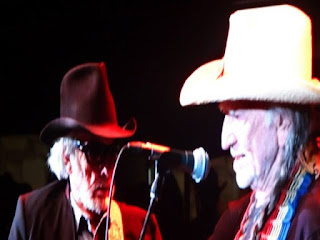
\
Merle and Willie
Eric Church sang a lot about smoking and drinking and appealed to only a certain demographic in the audience.
Eric Church
Willie finally came on around midnight but much of the audience was in a more subdued state of mind by this point, having reached a peak of appreciation earlier when Willie joined Merle Haggard for “Pancho and Lefty” and “It’s all going to pot”. Nevertheless we sang along with his classics and filed out in an orderly fashion after an obligatory encore.
Willie and family
Being 20 miles out of Austin without a car at the end of a Willie Nelson picnic isn’t as much fun as it first sounds and it is amazing how quickly panic and anxiety can replace euphoria. After much wandering around in the darkness we attempted hitch hiking at several spots before two women stopped and offered us a lift (for a fee). Assuring the female passenger (who claimed she had “not signed up for this”) that we were not murderers was a hurdle, but eventually we got in the car. As it turns out the driver was the daughter of a racing car driver named Masten Gregory. Known as the Kansas City Flash, he is in a distinct club of motorsport being only one of seventeen drivers to compete in all three legs of the Triple Crown of Motorsport (Indianapolis 500, 24 Hours of Le Mans and the Monaco Grand Prix) and to have won at least one of those events. At any rate, his daughter was a good driver and got us home for only $30.
Masten Gregory
As we drifted in to a deep sleep at 200 San Jacinto Blvd. we were blissfully unaware of a drama unfolding only blocks away at the nearby Omni Hotel (700 San Jacinto Blvd.) Michael Holt, 35, was seen with a rifle at 5 am in the lobby. Moments later a 911 call came saying he had shot a man in the lobby and police responded and shot Holt dead. The innocent bystander killed was 60-year-old Yellow Cab driver, Conrado Guadalupe Contreras.
The next day (Sunday) was a late start but we managed to make it to the afternoon show at the Continental Club where the Casper Rawls Band included, on this occasion, bass player Glenn Fukunaga and Merle Haggard’s piano player Floyd Domino. As a former member of Asleep at the Wheel – which he joined at 17 – Domino had joined the band for a guest spot at the previous day’s Picnic.
With Casper Rawls Band
In the evening the FIFA women’s world cup final (USA v Japan) was on everyone’s mind and we took the opportunity to watch it at a bar in Rainey Street where chants of "You Ess Ay" echoed along the once sleepy residential street. Rainey Street was rezoned as part of Austin’s CBD in 2004. Bars and eateries have flocked to Rainey, since CBD zoning enables traffic-heavy cocktail bar or restaurant use without any additional zoning request. As such, old bungalows have been fixed up and turned into bars and cocktail lounges with ample backyards and porches. Examples are: Banger's Sausage House and Beer Garden, the Blackheart, Javelina, Jack and Diane's and Rainey Street Bar.
It was then back to the Continental for the mid evening show featuring the Wagoneers – a band popular in the 80s that opened for such diverse acts as Bill Monroe and The Ramones, and featuring guitarist Brent Wilson.
On our uber trip home we observed a stationary police car on Congress Avenue Bridge as crowds gathered to watch the bats fly out. Two officers were attempting to subdue a suspect in a not too subtle manner and back up had obviously been called for. We passed seven police cars racing to the scene, but continued homewards to get some sleep before flying to Dallas.
Dallas was hot and windy when we landed but we were pleased to find we had a good view of the Dallas County Jail from our room at the Hyatt Regency. We visited Reunion Tower (an observation tower with a revolving restaurant and 360° views, being the 15th tallest structure in Dallas), took a JFK assassination tour where we noted the area where Lee Harvey Oswald boarded in 1963 has not changed much, and explored Dealey Plaza and the Grassy Knoll before visiting the Sixth Floor Museum. At the Grassy Knoll we bought a souvenir newspaper from a vendor who assured us that Oswald could not have acted alone and that secret service agent Clint Hill had changed his original statement (Hill’s modified statement that Oswald acted alone is presented to visitors in the Reunion Tower and now matches the official line).
On the Grassy Knoll
Monday evening in Dallas is not the most lively night of the week but fortunately Adair’s Saloon at 2624 Commerce St, offers live country music 7 nights a week. We were able to chow down on one of the nicest but least healthy cheeseburgers I have experienced to the sounds of the
Troy Cartwright band (Troy Cartwright is a country singer and songwriter born and currently residing in Dallas. He graduated from the Berklee College of Music, was selected as the winner of the 25th annual B. W. Stevenson Songwriting Competition, and was the recipient of the 2014 Rising Star Texas Music Award).
The following day we visited the A T & T stadium – a city-owned 85,000-seat capacity stadium with a retractable roof in Arlington (the guide told us the roof is opened so God can watch his favourite team play). It serves as the home of the Dallas Cowboys - one of the most valuable sports clubs in the world with a value of $2.3 billion. The facility can also be used for a variety of other activities outside of its main purpose (professional football) such as concerts, basketball games, college and high school football contests, soccer matches, as well as motocross and Spartan races. It was interesting to learn that on Feb. 14, 2010, the NBA All-Star game drew a 108,713 strong crowd. The Cowboys’ first home game in the stadium still stands as the largest regular-season crowd with 105,121 people, whilst George Strait’s June 2014 concert became the largest indoor concert in North America as 104,793 people packed AT&T Stadium. It broke a 33-year record previously set by The Rolling Stones in New Orleans in 1981, when an estimated crowd of 87,500 people crammed into the Superdome. Although Kenny Chesney and Jason Aldean drew a crowd of only 47,256, on May 16 2015, Chesney’s songs “Drink it up” and “Beer in Mexico” generated record beer sales at the stadium.
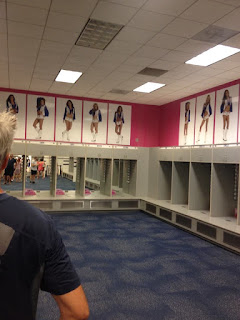
Cheerleaders change room
On the playing field
`
Not looking forward to a four stop journey home (Dallas-San Francisco-Los Angeles-Sydney-Melbourne) we nevertheless fronted at Dallas Love Field airport. At San Francisco the flight to LA was delayed and delayed until we were unable to make the connecting flight to Sydney. News reports said United Airlines flights were grounded for almost two hours due to a computer hardware problem, creating travel headaches for tens of thousands of passengers. After a ninety minute wait in a queue at the United Airlines service desk in Los Angeles we were allocated tickets on the following night’s flight to Sydney and given a voucher for a room at the Concourse Hotel and a voucher for a $21 meal at participating outlets.
The 24 hour delay provided the opportunity for a quick trip to Hollywood where vendors pushed marijuana cards (i.e. cards that would allow you to get medical marijuana) for $25 as they jostled for sidewalk space with scientologists offering personality tests, Jehovah’s witnesses offering free booklets and Chinese Christians imploring people to turn to Jesus before entering the adult bookstore. At a set of traffic lights on Hollywood Boulevard I coincidentally ran into Quinn Toohey from Melbourne – proving the world is indeed a small place these days.
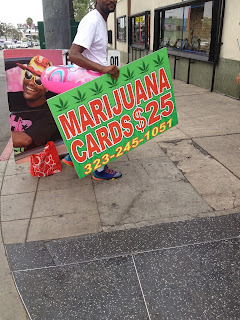


Later that evening our United Flight did take off and 14 hours later I was in Sydney amongst 3000 passengers from all parts of the globe trying to negotiate the Australian Customs system. The back pain had returned and news of Collingwood’s 3 point loss to Port Adelaide added enough mental anguish to cause temporary separation from my travelling companion (my son Will). We were re-united on the Qantas flight to Melbourne and lived happy lives.
